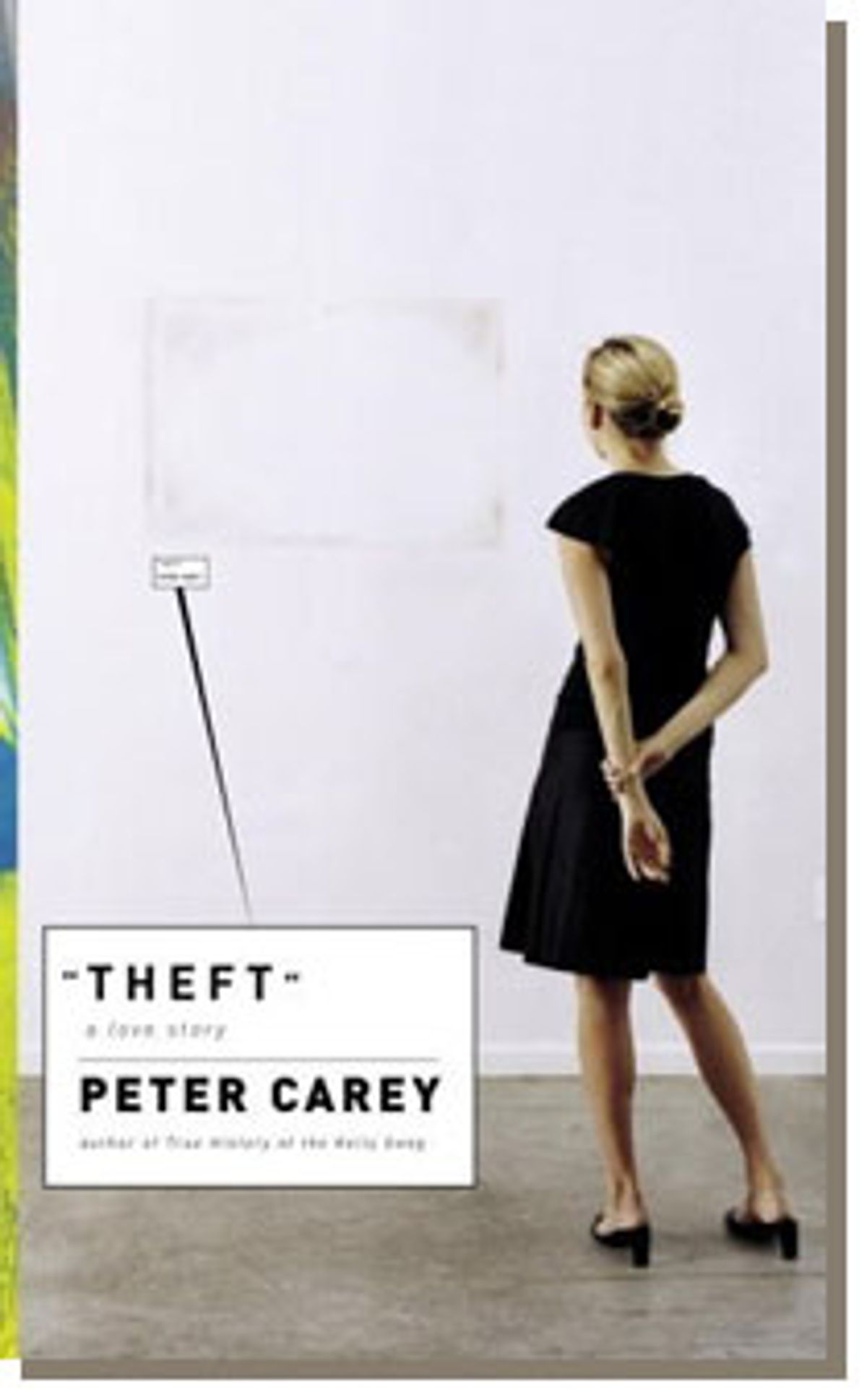"Good artists borrow; great artists steal," said Picasso or T.S. Eliot or Salvador Dali -- no one seems to know which. Peter Carey's new novel, as wily and diverting as the ones before, treats of all the ways that art and theft intersect in the lives of two brothers, Michael "Butcher Bones" Boone and Hugh "Slow Bones" Boone. The items purloined include: paint, canvas, a spouse, a son, a patrimony, an artist's style, an artist's finished work, the right to authenticate an artist's work, a forgery, a human life and a folding chair. "Theft" is a hard-boiled detective story of sorts, complete with an ingenious conspiracy and a ravishingly deceitful femme fatale.
The novel is set in the early 1980s. Michael is a burnt-out Australian painter who "had once been as famous as a painter could expect to be in his own backyard." A bad divorce and the shifting styles of the art world have cast him onto hard times. Plus, there's the little matter of the prison stint he did after being caught trying to steal back the paintings his ex-wife won in the divorce settlement. And the restraining order. Now he's reduced to serving as unpaid caretaker in a borrowed cabin outside a small, swampy, buggy Australian town.
Michael doesn't have much, but he does have Hugh, either his burden (if you ask Michael) or his invaluable dogsbody (if you ask Hugh). What's wrong with Hugh isn't quite clear -- at times he seems almost autistic, at others merely simple-minded -- but he can't take care of himself, and he has an unfortunate tendency to get violent when enraged or overwhelmed. This is a very unfortunate tendency, considering that Hugh is 6-foot-3 and 225 pounds. His specialty is snapping people's little fingers. The novel is told in alternating first-person chapters by each brother, Michael's full of fury and ravings against "the other team, the market, the rich guys, the ones who decided what was art and what was not" and Hugh's a milange of stray memories, obsessive fears, shrewd insights and Joycean fancies ("He was a licky dog").
Into the brothers' lives and through the country mud, balanced on a pair of Manolo Blahniks, walks Marlene Leibovitz, the wife of the son of the late Jacques Leibovitz, a great modernist painter. Since Marlene's husband can't stand the sight of his father's work, she has assumed his droit moral, the legally inherited right to authenticate the works of Jacques. The task is a tricky one, since after Jacques' death, his wife made off with dozens of unfinished and abandoned works, "completed" them in her own mediocre hand, and tried to pass them off as the real thing. The world of "Theft" is full of bogus Leibovitzes.
Marlene seems to genuinely care for Michael and to believe that his current work is important, but like a lot of the Leibovitz paintings out there, she's not what she seems to be. Michael, who -- like Marlene, he will eventually discover -- grew up in the middle of the Australian nowhere, can't help admiring and identifying with the way that she's completely re-created herself as an art world player. Hugh likes the fact that she's read his favorite book, "The Magic Pudding," twice. Newly inspired, Michael has just completed a series of paintings, crowned by a "beautiful seven-foot-high monster" painted in "greens so fucking dark, satanic, black holes that could suck your heart out of your chest." Marlene resolves to revive his career and the results take them to Sydney, Tokyo and, finally, New York.
The particular treasures offered by "Theft" are the novel's window into the crass, Byzantine workings of the art market and Michael's semidemonic, but palpably authentic, artistic passion. There are lots of novels that rhapsodize about great paintings, but this one makes you feel the tactile, unprettyfied glory of painting. Michael's patron offers him the use of a riverside studio complete with ample natural light and a luxe coachwood floor, and as soon as the man is out the door, Michael puts down a floor of sheetrock and strings banks of incandescent floodlights from the expensively arched roof; these are the conditions a real painter (as opposed to a lifestyle painter, like the patron) needs to work.
Novelists with crushes on Vermeer might squander their precious lyricism on descriptions of pictures, but Carey knows that what drives painters mad with lust is the paint itself. When Michael gets his hands on the good stuff, the prose almost throbs. He takes these elemental substances and makes canvasses "layered like licorice allsorts, sedimentary rocks, green, black, gorgeous yellow, sparkling mica, fool's gold they call it ... Then I invaded ultramarine blue with a force of sweet burnt umber, thus giving birth to a new black as warm as a winter blanket for a twenty-thousand-dollar horse, and then I stained my cotton duck with a very fucking diluted dioxane purple, so watered-down it was a pearly grey, a secret skin."
Is Michael a "great" painter? That's the real mystery at the center of "Theft." In the end, the novel leaves us unsure if Marlene has stolen away the possibility that he'll ever know the truth about this, or freed him from the corrosive desire to know it. Still, I came away thinking that he was, if only because his creator does this very hard thing -- conveying the genius of one art form in another -- so masterfully.



Shares